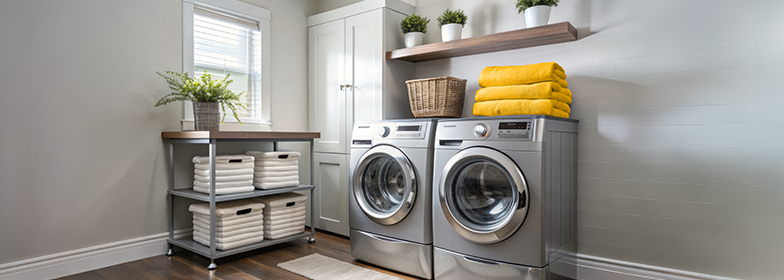
Can energy-efficient homes qualify for special mortgages?
In addition to being better for the environment and your wallet, energy-efficient homes can get you unique and cost-effective home loan financing. Whether you’re purchasing a home to make it more eco-friendly or refinancing with energy upgrades, energy-efficient mortgages (EEMs) allow buyers to qualify for special loans that combine their home financing with green improvements. From simple appliance swaps to solar panels, you can afford the home you want while making sustainable upgrades along the way. Read on to discover what they do, how to qualify and the differences between them.
What is an energy-efficient mortgage (EEM)?
An EEM is a special mortgage that combines the costs of certain clean energy improvements such as renewable energy projects or energy-efficient appliances. Most EEMs are available for both home purchases and refinancing.
Because they combine all assessment and installation costs into your mortgage, they can be very useful in helping you avoid paying out-of-pocket costs for each part of the process. Plus, you may qualify for a larger loan amount because of the potential energy savings.
Types of energy-efficient mortgages
There are a handful of different EEMs to choose from, depending on your financial situation and the kinds of energy-efficient upgrades or additions you want to make. Below are a handful of loan options that Guild offers.
| Name of EEM | Type of loan | Best uses | Purchase or refinance? | Additional info |
|---|---|---|---|---|
| Fannie Mae HomeStyle Energy | Conventional | Weatherization updates, solar, smart thermostats and more | Both | Can also be used to pay off existing expenses for energy upgrades |
| Fannie Mae Solar | Conventional | Photovoltaic (PV) solar energy additions | Purchase | New construction homes are eligible |
| FHA Energy-Efficient Mortgage (EEM) | Government (FHA) |
General energy-efficient improvements | Both | Requires Home Energy Rating System (HERS) audit |
| FHA Solar | Government (FHA) |
Photovoltaic (PV) solar energy additions | Both | When paired with the Hope for Homeownership Program (HOPER), borrowers are eligible for down payment or closing cost assistance |
| GreenSmart Advantage Program powered by The Home Depot® | Government (FHA) |
Appliances and smart thermostats | Purchase | Standard FHA guidelines apply; select states are eligible |
| VA Efficient Mortgage (EEM) | Government (FHA) |
Heating and cooling systems, insulation updates | Both | Financing usually up to $6,000 |
EEM incentives by state
Many states offer their own energy-efficient incentives for homeowners and homebuyers. From updating HVAC systems and installing solar panels to providing credit for ENERGY STAR appliances, we recommend checking your state’s energy directory to see if there are rebates or special financing you may qualify for. Many states offer these initiatives not only to become more climate-friendly but also because of potential home value increases.
Federal programs like the U.S. Department of Energy’s Weatherization Assistance Program (WAP) for low-income households have also been adopted and customized by some states. Additionally, when tax season comes around, you may be able to take advantage of a residential clean energy credit.
How to qualify for an EEM
Qualifying for an EEM follows a similar process as any other mortgage, but with a few additional steps depending on the program you’re interested in.
- Contact a loan officer: Discuss financing options for the energy-efficient upgrades you want to make when you buy or refinance. Your loan officer will help you determine if an energy assessment is needed.
- Apply for the EEM: If approved, you’ll be able to finance the upgrades into your mortgage.
- Get to work: Find licensed contractors to start creating energy-efficient improvements for a quote.
- Close your loan.
- Final confirmation: Upon completion of the project, your lender will conduct a final inspection to confirm that your home is more efficient than before.
Requirements for an EEM
Usually, the same credit score requirements, debt-to-income ratio, maximum loan limits and down payment minimum amounts are required for both Conventional and Government EEMs as their non-EEM counterparts.
It’s highly recommended to get a home energy professional’s assessment, so they can prove to your lender that your renovations are cost-effective updates: meaning, these improvements will save you more than they cost.
Some down payment assistance programs, like the Hope for Homeownership Program (HOPER), can be combined with EEMs like FHA Solar to provide down payment or closing cost aid. Your eligibility often depends on whether you’re a first-time or repeat homebuyer.
Overall, energy-efficient mortgages can be a great way for you to purchase the green home of your dreams or afford renovations for your existing home. Whatever updates you’re looking for, there’s potentially a financing option for it. Start planning your energy-efficient home journey today with a loan officer in your area.
The above information is for educational purposes only. All information, loan programs & interest rates are subject to change without notice. All loans subject to underwriter approval. Terms and conditions apply. Always consult an accountant or tax advisor for full eligibility requirements on tax deduction.
